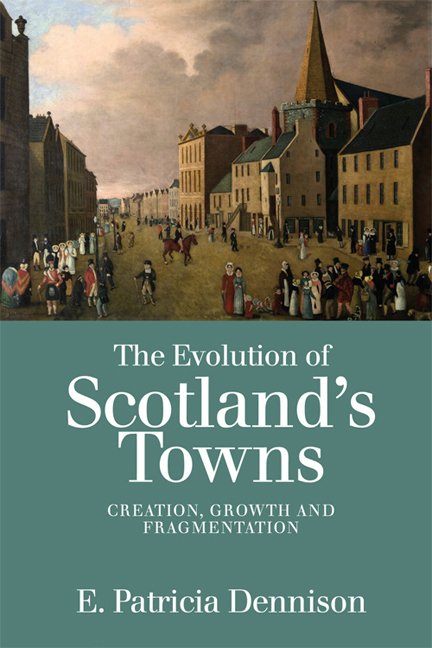Book contents
- Frontmatter
- Contents
- List of Figures
- Acknowledgements
- Image Credits
- List of Abbreviations
- Introduction
- 1 Medieval Towns
- 2 Daily Life in the Middle Ages
- 3 Medieval Faith and the Church
- 4 Encroachment on Burgh Society, 1550–1750
- 5 Man-made and Natural Disasters, 1550–1750
- 6 The Birth of Urban Scotland
- 7 The Victorian Town
- 8 The Twentieth Century
- Post-script: Footprints to Fragmentation
- Appendix: Population Statistics – A Select List
- Bibliography
- Index
6 - The Birth of Urban Scotland
Published online by Cambridge University Press: 11 November 2020
- Frontmatter
- Contents
- List of Figures
- Acknowledgements
- Image Credits
- List of Abbreviations
- Introduction
- 1 Medieval Towns
- 2 Daily Life in the Middle Ages
- 3 Medieval Faith and the Church
- 4 Encroachment on Burgh Society, 1550–1750
- 5 Man-made and Natural Disasters, 1550–1750
- 6 The Birth of Urban Scotland
- 7 The Victorian Town
- 8 The Twentieth Century
- Post-script: Footprints to Fragmentation
- Appendix: Population Statistics – A Select List
- Bibliography
- Index
Summary
The century and a half which spanned the years from 1750 to the end of the Victorian era saw immense social and economic changes, which both galvanised and threatened life in towns and the townscape. Scotland moved from being an overwhelmingly rural country to one of the most urbanised societies in Europe. If the measure of urbanisation in western Europe is a population of 10,000 inhabitants or more, Scotland stood at seventh place in 1750, rising to fourth in 1800, and by 1850 it was second only to England and Wales. Glasgow's population rose from 77,385 in 1801 to 274,533 forty years later (see Appendix, pp. 299f.). In 1851, 22 per cent, that is one in five, of Scottish residents lived in one of the four big cities – Glasgow, Edinburgh, Dundee and Aberdeen. This would rise to 30 per cent by 1911 and, if Partick, Govan and Leith were included, the proportion was even higher at 35 per cent.
Very few new towns sprang up, unlike in England. On the other hand, most towns – medium-sized or small – grew in population. The dynamics and pressures operating within small-town Scotland varied immensely but were none the less viewed with apprehension by burgh authorities and local ministers of the church alike. The combination of steady, incremental industrialisation, fuelled first by migration from both rural hinterlands and the Highlands and, from the 1790s onwards, by Irish immigration, posed an alarming prospect: an alien workforce, under-educated and often unchurched, likely to become an unpalatable drain on public charity and a threat to established order. Such fears were understandable and this century and a half would witness quite staggering cultural and economic changes.
Improvement and Enlightenment
The second half of the eighteenth century has sometimes been classified, deservedly, as the ‘Age of Improvement’. Growing awareness of the necessity for increased sanitary measures, for townscape- and land-management and for better communication networks held its roots in the earlier eighteenth century and before. Seventeenth- and early eighteenth-century efforts to clean up towns continued with a deeper understanding of the need for progress.
- Type
- Chapter
- Information
- The Evolution of Scotland's TownsCreation, Growth and Fragmentation, pp. 170 - 208Publisher: Edinburgh University PressPrint publication year: 2017

